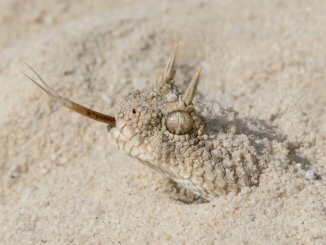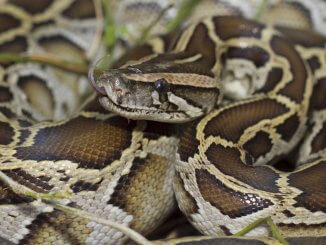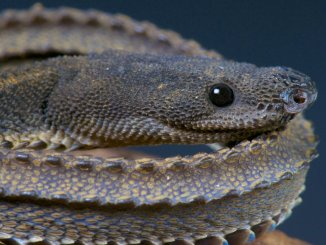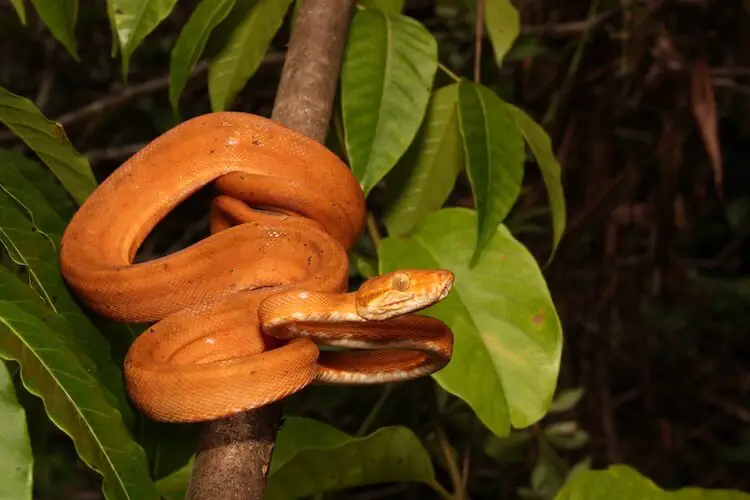
Are you interested in a long, colorful snake with an exciting personality?
The Amazon Tree Boa is one of the most popular climbing snakes in the world. They are born via live birth and come in many different colors and patterns.
Their beautiful colors make them a stunning snake to add to any home. But these snakes also have a fearless personality. Their personality can sometimes make them defensive and difficult to handle. This means they have specific care needs and handling strategies.
Continue reading below to learn about the specific care needs for this Boa and how to handle them safely.
All About Amazon Tree Boas
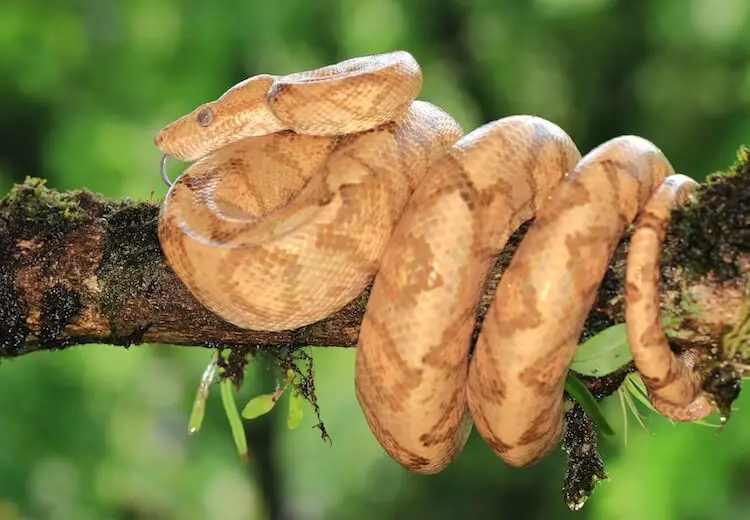
The Amazon Tree Boa (Corallus hortulana) is a long, slender snake from the Boidae family. They are found throughout the entire neotropical region of South America, including Brazil, Venezuela, Colombia and Peru.
Tree Boas are often found living in rainforests and humid areas near rivers, but they are also happy to live in developed ecosystems like farmlands and urban areas.
Like many snakes, this species was named and described by Carl Linnaeus in 1758, but it was largely ignored by researchers. Until exports to the USA increased in 2000, many keepers were not even aware of this species.
Since 2000, they have become one of the most popular climbing snakes, and many captive breeding programs have been started. Recent research on the species has also led to more knowledge about their care and behaviors.
We know these snakes are polymorphic. This means their offspring are produced in an unpredictable variety of colors and patterns. This diversity is one of their best traits as it produces many vibrant colors.
Amazon Tree Boas make great beginner snakes for any keeper that wants a colorful species with an exciting personality.
One of the reasons they are popular is also because of their ferocious appetite.
Amazons are ambush hunters. Just like the Carpet Python, they have heat sensing pits that make it easy for them to detect prey. This skill is useful in the wild, but it can make them unusually defensive as a pet. It also makes them prone to striking. With a lot of work, these snakes can be tamed down, but many always remain defensive to some degree.
These Boas also require specific care and husbandry.
Any keeper should follow a strict, consistent husbandry plan that takes a lot of work and effort. Failure to do so can lead to obesity, skin conditions, dehydration, and other health problems for your snake.
As a climbing species (i.e. arboreal snake) from the tropical treetops of Brazil, it is also important to build a proper habitat for them. A six foot vertical enclosure is needed to provide enough space for your snake to move and find enriching perches to climb on.
| Quick Overview | |
|---|---|
| Common Name | Amazon Tree Boa, Garden Tree Boa, Common Tree Boa |
| Scientific Name | Corallus hortulanus |
| Family | Boidae |
| Genus | Corallus |
| Similar Species | Green Tree Python, Ball Python, Brazilian Rainbow Boa |
Appearance and Size
Amazon Tree Boas are long, slender-bodied snakes. Adult species are usually only two inches in diameter but can reach lengths of between five and seven feet. Hatchlings are normally born 12 inches long and also have very thin bodies.
The average weight of an Amazon Tree Boa ranges from 600 to 900 grams. Some females can grow to over 1,000 grams but this isn’t common. Males tend to be on the shorter end of the spectrum with slightly smaller heads
Colors
If you are looking for a beautifully patterned snake with a variety of colors, then look no further!
Their beautiful and striking appearance makes them one of the most popular snakes.
Interestingly, these snakes are polymorphic. This means each clutch has an unpredictable mix of patterns and colors. Selective breeding has led to mildly predictable clutches in later generations, but the variety of morphs produced is still high compared to other species like ball python morphs.
These boas are grouped into two color phases:
- Colored
- Garden
Colored individuals can be harder to find and more expensive, but they are beautiful combinations of yellow, red and orange. Garden phase species are usually dull brown, black and gray. These snakes also have black tongues and long, sharp teeth to grip prey.
The amazing pattern variety in garden Amazon Tree Boas makes up for their dull colors. Their pattern can be banded, speckled, saddled or plain.
One of their most notable characteristics is their bright, bulging eyes that can be shades of metallic golden-bronze or reddish with vertical pupils. Their eyes also have a reflective membrane that gives them eyeshine at night, like cats and alligators.
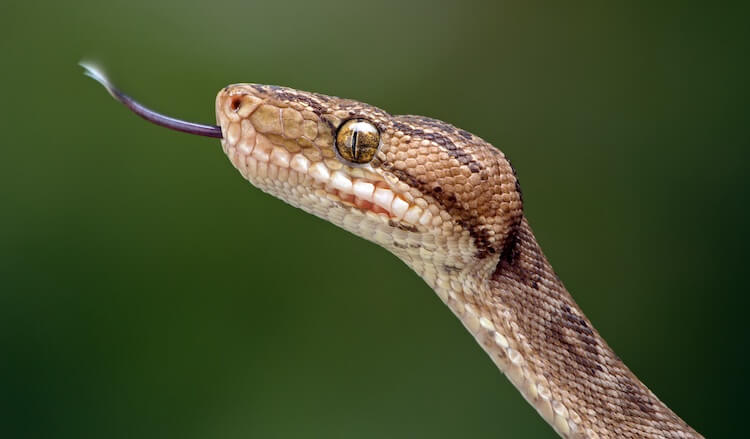
How Much Is An Amazon Tree Boa?
Garden phase Amazon Tree Boas normally cost $100 to $200. If you are looking for a colored phase, or a high contrast pattern, you will need to pay $500.
When you include the price of the snake, enclosure, hides, décor, substrate, and equipment, your total cost will be $1,000 to $2,000. This price range depends on the species you buy and the quality of the enclosure.
Amazon Tree Boas are still heavily trafficked from the wild.
Wild snakes often have parasites, skin conditions, and life-long aggression issues. Wild collecting also puts pressure on natural populations and harms local ecosystems.
Amazon Tree Boas are harder to find than some species, like a ball python, but they are still available in many pet stores.
It is important to find a captive breeding facility that only sells captive-bred species. When choosing a breeder, look for someone who has multiple generations in their care.
Once you have chosen a breeder, make sure you handle their juveniles. This will help you to better understand their health and behavior. Look for a snake that is alert, active and hostile. A defensive juvenile is a good sign that they are healthy. If the snake seems lethargic, or is wheezing, it could be sick or injured.
What Do Amazon Tree Boas Eat?
The Amazon Tree Boa is a specialist at eating many different types of vertebrates. But, they have no preference for the type of vertebrate they eat. These Boas mostly eat mammals and reptiles with backbones. Prey in the wild often includes:
- Birds
- Bats
- Frogs
- Lizards
- Rodents
- Small Marsupials
Tree Boas are nocturnal hunters that catch prey in trees. They use their tails to hold on to branches and hang their bodies down in an S-curve. When prey lands on a branch, the camouflaged Boa will strike. They knock the prey off the branch and quickly coil around them.
Babies should be started on pinky mice. They prey mostly on lizards and frogs in the wild, so it may take a few tries to get a hatchling to accept rodents. If you struggle to get your Boa to eat, then try offering a live pinky mouse for the first meal.
Moving An Amazon Tree Boa Up From Pinkies
Hatchlings should be fed every seven days until they are large enough to accept fuzzy mice. This is normally around three months. At this point, you can feed them every 10 days.
Sub-adults and adults, around two years old, can be fed every two weeks.
As your snake grows, increase the size of the rodent to match the girth of the widest part of their body. A hungry snake will start to forage along the floor at night for food. Your snake should stay slender and have a mildly rounded body shape around their spine.
Rodents make a great staple food, but it should not be the only thing you feed. It is important to include variety in your snake’s diet. You can do this by purchasing frozen feeder chicks and other rodent species.
Are Amazon Tree Boas Aggressive?
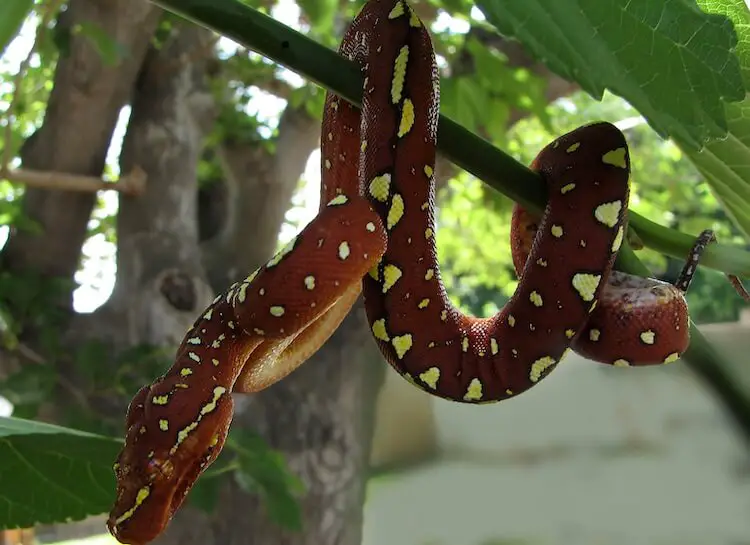
Amazon Tree Boas are solitary, defensive snakes. They rarely interact with other species and are highly aggressive. Even cohabitated Amazons of opposite genders have been seen fighting.
Some Amazon Tree Boas can be handled with great care, but many will not tolerate it. They tend to be overly defensive. Boas are naturally very quick ambush predators and have a very strong feeding response. This can lead to accidental bites if you approach them too quickly with your hand.
Babies tend to be very defensive. Only with frequent and gentle handling can they eventually get used to it. They will stay defensive for their entire lives, but frequent exposure can reduce their aggression.
The best way to avoid a bite is to practice safe handling.
Before picking up a snake you should always warn it. Start by rubbing or nudging your Boa gently with a hook. Once the snake begins to move away, it means that it does not feel threatened. At this point it will likely allow you to handle it.
Your snake will spend most of its time basking, coiling on branches, or climbing.
They are also known to use humid hides before shedding or during the brightest parts of the day. Occasionally, they may also be seen soaking in their water dish. It is normal to see a combination of these behaviors. It is one of the reasons they are so enjoyable to keep.
Amazon Tree Boa Setup
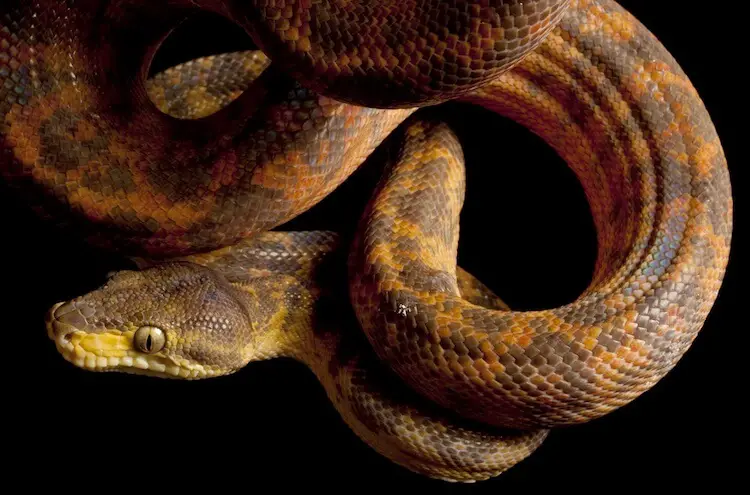
Boas tend to stay in humid rainforests along river edges, but occasionally they have been found in drier forest or savanna regions. Regardless of the habitat, these snakes are almost always found in bushes or trees.
It is important to include many aspects of their wild habitat in their tank.
First and foremost, an arboreal tank made of glass is important. Tall tanks are essential for arboreal snakes to encourage climbing and coiling on branches. Your enclosure should be at least as tall as your snake is long. More space is always better.
Amazon Tree Boas do not require any special UV lighting, but they do require specific temperature gradients. The enclosure should have an ambient temperature on the cool side and along the bottom of 70 to 75°F.
There should be an overhead heating element to create an 85 to 90°F basking area on one side of the tank. Place the heating element over a branch thick enough for your snake to comfortably coil on.
Using an overhead heater is important for this species as they do not bask on the ground.
When choosing a substrate for the tank, humidity is the most important factor.
To maintain a humidity of 50 to 70%, an absorbent substrate is necessary. Typically, keepers use coconut fiber or fertilizer-free top soils.
Décor and plants are important to help your snake feel safe and secure. Amazons are known to blend into colorful backgrounds of leaves and flowers. In an empty enclosure, your snake may feel stressed.
You should also provide many climbing perches that are at least the thickness of your snake. In addition to climbing perches, you should also have three hides. Hides should be placed on the floor of the enclosure on each end, and a hanging hide can be added on the cool side.
A few quick tips:
- Never use an under tank heater, snakes that live in trees will not bask on the ground.
- Snake safe plants can be used, but these climbers typically destroy any live plants.
- Avoid substrate combination mulches as it irritates their lungs.
- Give them a 12-hour light cycle.
Health and Husbandry
Amazon Tree Boas have a typical lifespan of between 15 and 20 years. Routine husbandry, and a carefully monitored feeding schedule, can help to make sure your snake lives to the fullest.
This snake is susceptible to many of the same diseases that other captive species suffer from. Some of the most common include:
- Respiratory infections.
- Skin mites.
- Fungal infections on the skin.
- Intestinal parasites.
The Amazon Tree Boa is also prone to some more specific health issues.
One of the most severe is inclusion body disease. This disease is poorly understood and totally untreatable. It causes regurgitation, anorexia, lethargy and neurological symptoms called “star-gazing”. In all affected snakes it eventually leads to death. If you suspect your snake is developing inclusion body disease, quarantine it immediately and contact a vet.
Another major issue for this species is obesity. Because they are slow growing, and slender snakes, overfeeding can quickly cause obesity. Power feeding Amazon Tree Boa leads to long term health problems and greatly shortens their lifespan.
They are also prone to dehydration. It is important to include a water bowl large enough for soaking in the enclosure. Misting the enclosure twice daily will also help to keep your humidity between 50 and 70%. It should peak at 90% right after misting.
Wrapping It Up
Amazon Tree Boas are loved for their beautiful colors and spunky attitude. They are very long, slender snakes that love to climb. They will spend most of their time perfectly coiled around branches.
The Amazon Tree Boa is a snake best suited to intermediate keepers. They can be defensive and aggressive, so this makes it hard for new keepers to bond and care for them. They also have a strict enclosure setup and feeding needs. However, with some preparation, and enough experience, it is possible to bring one of these snakes home without a problem.
Boas can be overly defensive at a young age, but, with careful and frequent handling, they can learn to tolerate it. If you are looking for a snake that enjoys handling, and is also colorful, then check out the banana ball python.
With the right preparation, Amazon Tree Boas are one of the most rewarding arboreal boas to keep. If you are ready for a little bit of excitement, consider bringing one of these amazing snakes home.

